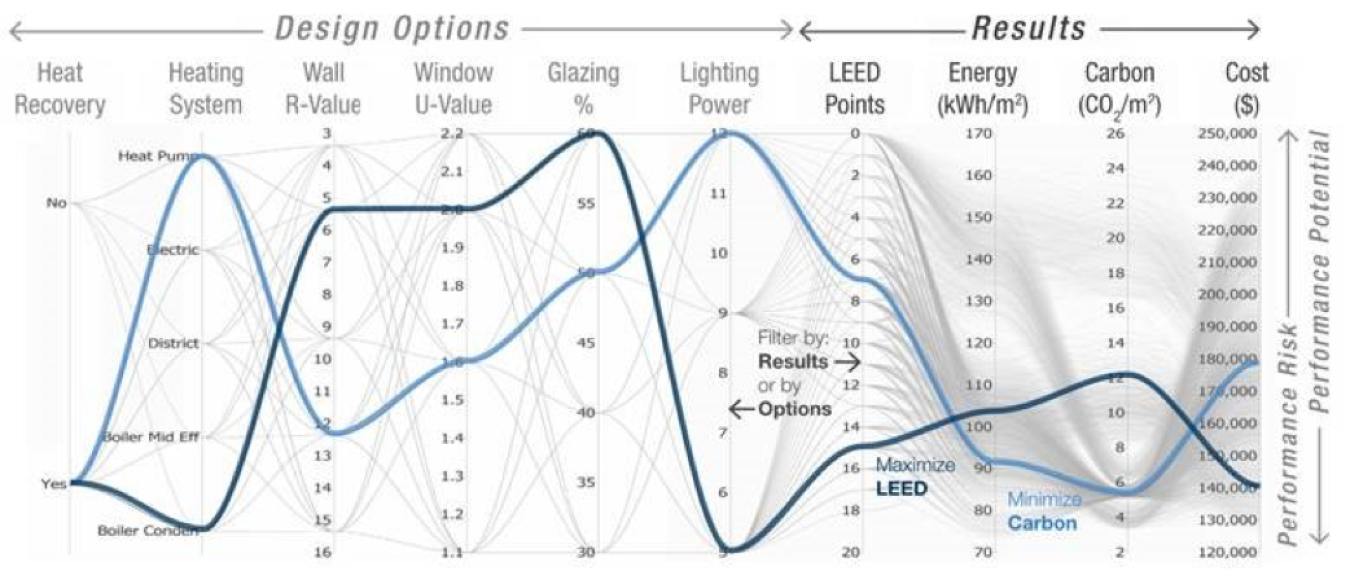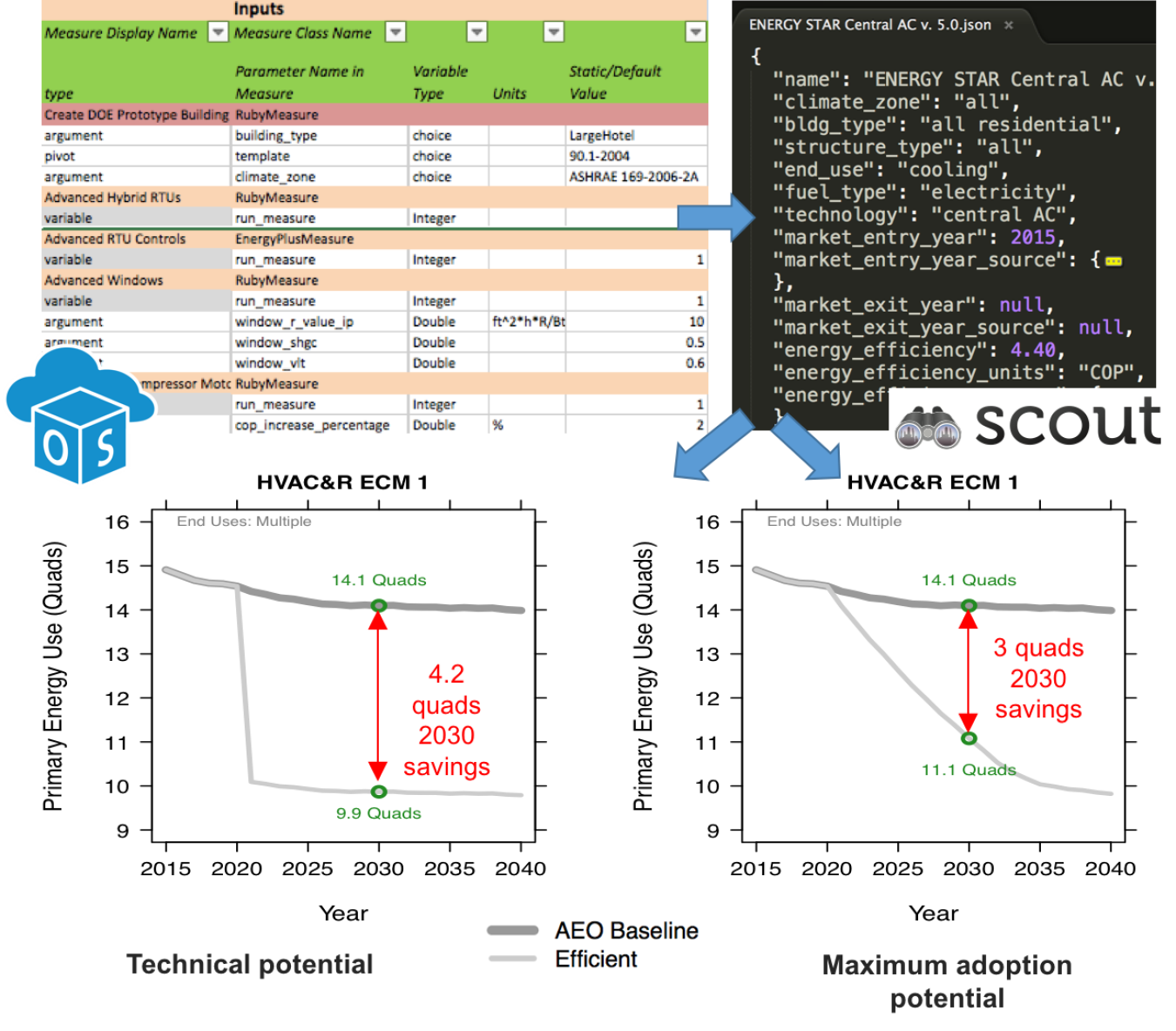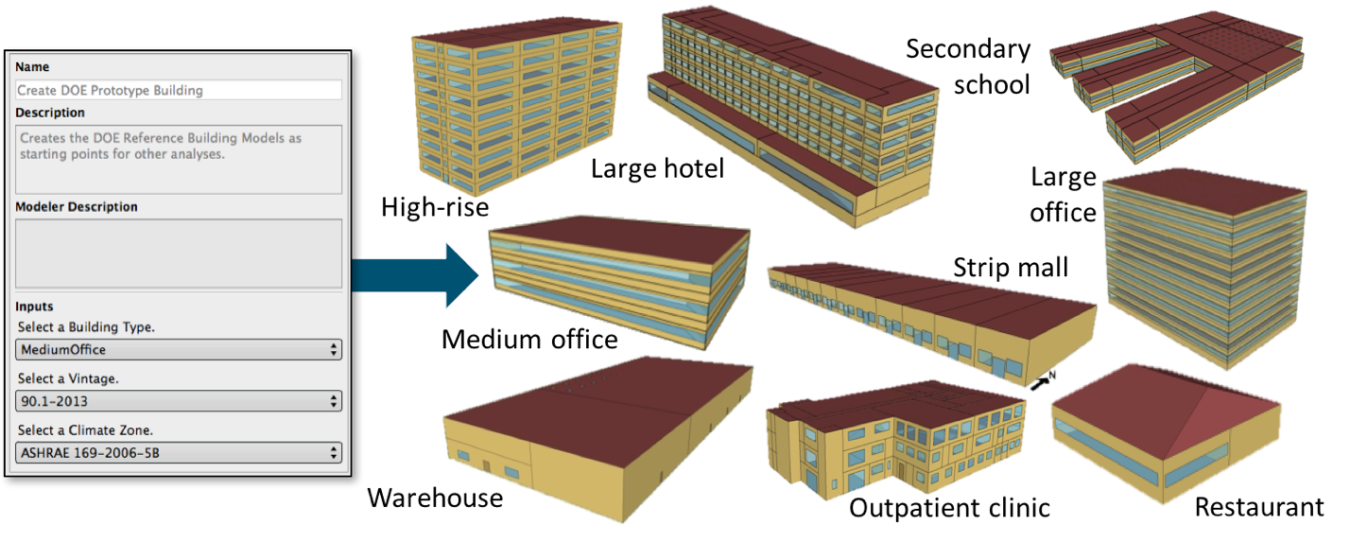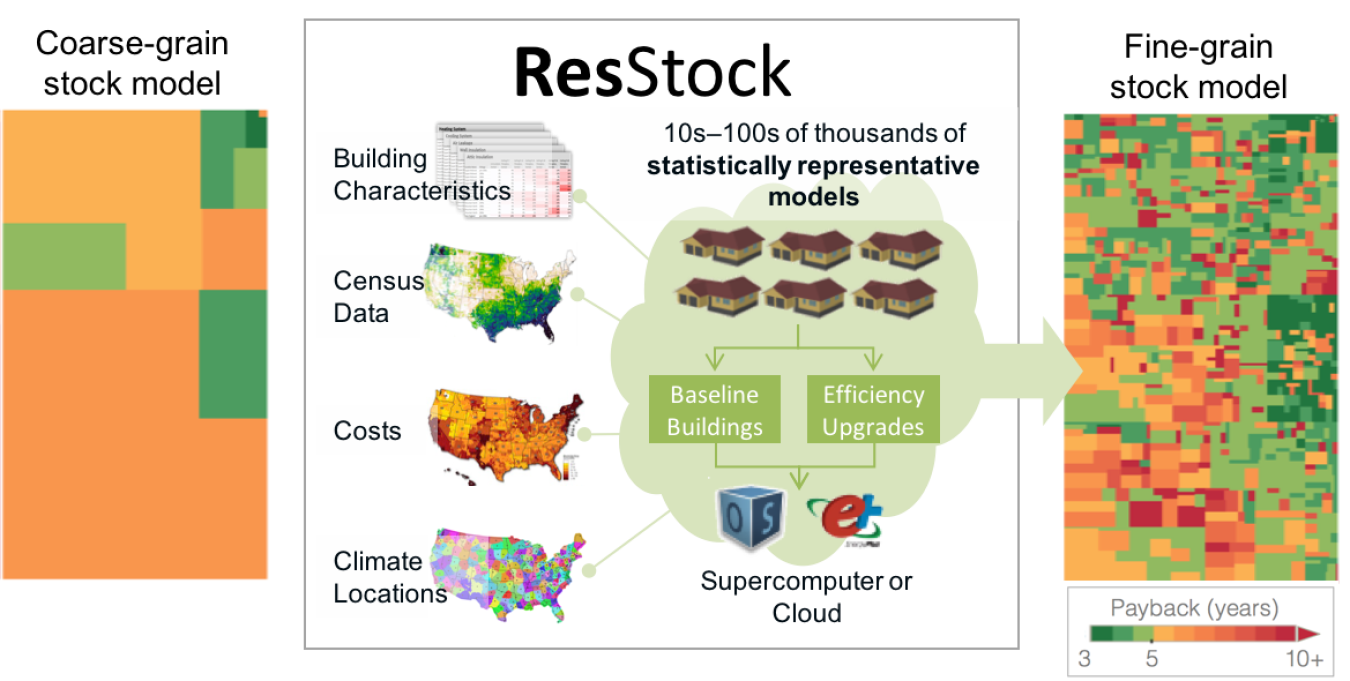Many energy-efficiency analyses involve entire building stocks rather than individual buildings.
April 18, 2017
Large-scale BEM is not just for stock-level analysis. Combined with the right visualization techniques, large-scale simulation can help building design professionals thoroughly explore the space of options around a central design concept to find combinations of strategies to meet performance, cost, or certification targets. A powerful and increasingly popular visualization device is the parallel dimension plot, which organizes and allow users to navigate large numbers of experiments. This plot shows over 1,000 EnergyPlus simulations, which can be visually searched on the basis of both design aspects (heating system type, glazing ratio, insulation values) and output metrics (energy use, cost, LEED credit points). Credit: Christian Cianfrone, Morrison Hershfield.

Scout is DOE’s impact analysis tool for building energy efficiency technologies. Scout uses EIA Annual Energy Outlook (AEO) data to represent US building stock energy use at the granularity of climate-zone, building-type, building-vintage, fuel-type, end-use, and technology-type and to evolve the stock forward using projections for new construction, retrofits, and equipment replacement. Within this framework, Scout evaluates the impacts of Energy Conservation Measures (ECMs) which are characterized by target energy segment, performance, cost, lifetime, and time-to-market. To evaluate competing technologies on an even playing field, Scout can use energy simulation on prototype building models to generate energy savings estimates by end-use. In this particular example, Scout is evaluating the energy savings of ENERGY STAR air-conditioners under technical (all air-conditioners upgraded immediately) and maximum adoption (all replacement eligible air-conditioners are upgraded). The picture on the top left shows the OpenStudio Analysis Spreadsheet specifying an ECM analysis on the “Large Hotel” prototype building which would feed into a detailed performance characterization of the ECM. In addition to individual ECM analysis, Scout can evaluate a ECM portfolio in which ECMs compete with one another for market share based on capital and operating costs. DOE leverages Scout to develop performance, cost, and lifetime targets for future energy-efficiency technologies.
.......................................................
Many energy-efficiency analyses involve entire building stocks rather than individual buildings. State energy offices may ask “how much energy can we save if we adopt the next code version?” Utilities ask “what efficiency measures should we incentivize within our territory to meet our regulatory energy savings requirements?” DOE asks “what technologies should we invest in to meet 2030 energy savings and economic goals?” These questions are difficult to answer using physical measurements on existing buildings. They can be answered much more practically using building energy modeling (BEM).
Prototype Building Models
Stock-level BEM analyses typically rely on prototype models; each prototype represents a segment of buildings within the stock. Even if a specific model for every building in a given stock exists—some utilities have models for every building in their service territory—using these for large-scale analysis may be too time-consuming and expensive.
The DOE commercial prototype building models have been used to support a wide range of analyses. Each batch comprises 256 models for each combination of building type (office, school) and climate zone (cold, hot-dry). Batches have been created representing different construction vintages (pre-1980, 1980-2004) and standards (ASHRAE 90.1-2004, 2007). To convert prototype model results to stock-level results, floor area scaling factors are applied. For instance, the secondary school prototype has a floor area of 211,000 square feet. If the stock in interest has 50,000,000 square feet of secondary schools, prototype results are scaled up by 237. For national-level analyses, floor area multipliers are extracted from the Energy Information Administration’s (EIA) Annual Energy Outlook (AEO) report.
The prototypical models are used to answer questions like the ones posed above. Pacific Northwest National Laboratory (PNNL) uses them to demonstrate energy savings and cost impacts of code updates at the state level—the ASHRAE 90.1 batches were created for this purpose. Utilities use them to calculate typical savings for energy-conservation measures (ECMs), for the purposes of incentivizing those ECMs up-front and reporting on savings to their regulators. DOE uses them in an in-house tool called Scout, to inform its technology investment portfolio and establish performance, cost, lifetime, and time-to-market targets for new energy-efficiency technologies. Scout evolves a building stock model forward under different technology, regulatory and market assumptions. Prototypical models are also used to develop EUI scales for the Home Energy Score, the Energy Asset Score and the ASHRAE Advanced Energy Design Guides and Retrofit Guides, as well as a variety of other applications.
Recognizing the importance of the prototype building models, DOE is working on supporting them in its OpenStudio platform. The OpenStudio standards gem includes the “Create DOE Prototype Building” Measure—a Measure is a Ruby script that accesses the OpenStudio API to transform a model in repeatable ways—that creates an OpenStudio model of the corresponding prototype building given the building type, the climate zone, and the code vintage.
To the Cloud
Stock-level BEM is well-established, but the emergence of cloud computing has made it both more powerful and more accessible. The cloud specializes at running large numbers of small programs, a good fit for stock-level BEM. Using the cloud, anyone can run 1,000 BEM simulations for about $10 and in under an hour.
As a producer and consumer of stock-level analyses, DOE has emphasized cloud-support in its OpenStudio BEM platform. OpenStudio Server is a cloud-ready container that includes EnergyPlus and the non-graphical portions of OpenStudio—the software development kit (SDK) and the Measure interpreter. Measures are key to leveraging the cloud because running a large number of simulations quickly and cheaply is only half the equation—defining the space of simulations to run systematically and efficiently is equally important. OpenStudio Server allows users to specify simulation spaces by combining seed models—e.g., prototype building models—with different sets of Measures.
Large-Scale Analysis for Individual Building Projects
All politics is local, and all BEM is single-building. Large-scale cloud-based BEM can benefit individual building projects as well as stock-level analyses. Uncertainty analysis can help identify risk areas while presenting BEM results as more realistic and helpful distributions and confidence intervals rather than unrealistically precise point estimates. Sensitivity analysis can help designers identify impactful design parameters as well as ones that can be modified without concern for performance. Going further, constrained optimization can help designers identify favorable regions in a design space. For existing buildings, calibration of model inputs using measured data from utility bills or advanced meters can improve models; automated calibration uses many simulations to hunt for input values that yield simulated results that match measurements. OpenStudio Server supports objective functions—fitness functions evaluated over individual simulations such as lowest energy cost or smallest difference from measured monthly energy use data—that enable analyses like design optimization and model input calibration.
DOE recently re-engineered OpenStudio Server to make it more flexible, robust, and easier to incorporate into applications. The similarly re-engineered Parametric Analysis Tool (PAT) demonstrates how this can be done. DOE is working with utilities, companies, and other organizations to leverage large-scale BEM in general and OpenStudio Server specifically in existing and new stock-level and individual-building applications.

Above, the commercial prototype building models cover 16 use types—offices, hotels, schools—and multiple vintages. They have been used to analyze energy-efficiency code updates, to estimate savings for up-front incentives, and in other applications.
Below, traditional stock models are coarse grain, often relying on a few prototype models to represent a single building type in a single climate zone. For some analyses, such coarse granularity can average out relevant details and return “all-or-nothing” results that miss significant opportunities. ResStock is a multi-resolution residential stock modeling framework. ResStock combines data from multiple sources including the EIA’s Residential Energy Consumption Survey (RECS) to create high-resolution conditional probability tables for home characteristics like square footage, insulation, window-type, HVAC type, and HVAC efficiency. ResStock then uses sampling to generate a statistically representative set of models for the desired region. ResStock leverages OpenStudio to create the models and run them. This particular example shows payback period “heat maps” for insulating wall cavities in various segments of the housing stock in Washington and Oregon. The traditional coarse-grain analysis misses multiple short-payback (green) regions, which represent cost-effective upgrade opportunities.

Dr. Amir Roth
Dr. Amir Roth is the technology manager for BTO’s Building Energy Modeling (BEM) subprogram and has served in that role since 2010. From 2001 to 2010 he was first an assistant and then an associate professor with tenure of Computer and Information Sciences at the University of Pennsylvania in Philadelphia. He graduated magna cum laude with a B.S. in physics from Yale University and holds a Ph.D. in computer science from the University of Wisconsin—Madison where he won a dissertation award in 2001. He is a member of the American Society of Heating, Refrigeration, and Air-Conditioning Engineers (ASHRAE), and the International Building Performance Simulation Association (IBPSA).
Email Amir Roth ►



